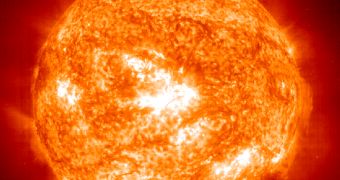The beginning of the 24th solar cycle, announced by the appearance of the first sunspot in the early days of the new year, caught the Ulysses spacecraft just over the north pole of the Sun. This is the first spacecraft to view the Sun's north pole in the first stages of a solar cycle. The Ulysses spacecraft is the result of a collaboration between NASA and the European Space Agency and was launched into space with the help of the Discovery space shuttle in October 1990.
The spacecraft was originally scheduled to be launched in 1983, but certain logistical problems pushed the date to may 1986. Through an odd coincidence, the Challenger space shuttle was designated to carry the satellite into space, but, unfortunately, the Challenger disaster in January 1986 further delayed the deployment of the satellite.
Unlike most of the satellites sent into space, Ulysses has an eccentricity of about 80 degrees in relation to that of the Earth, which enables it to make fly-bys over the poles of most of the rocky planets, Jupiter and the Sun. On the 14th of January, it passed right over the north pole of the Sun. Previous similar observations were available during the years 1994-1995, 2000-2001 and 2007.
During its 18 years service, the Ulysses spacecraft made detailed observation of gamma-ray bursts and several passings through the Tails of three comets, including the totally accidental passing through the ion tail of the Hyakutake comet on the 1st of May, 1996, event that revealed a tail measuring at least 3.8 astronomical units in length.
Ulysses' special orbit enables it to make observations that are virtually impossible from the surface of the Earth or from orbital planes parallel to the Sun's equator. Most of the scientific community believes that the Sun's poles represent the point of origin and flow for the solar cycle. As the sunspots disintegrate, the remnant magnetic field which generates them migrates towards the Sun's pole, with the help of large currents of plasma moving across the surface.
When they reach the pole, the remnant fields sink under the Sun's surface to an estimated depth of about 200.000 kilometers, to amplify the inner magnetic field, which will provide energy for future solar cycles. Observations conducted with the Ulysses spacecraft during the 23rd solar cycle revealed that actually the North Pole of the Sun has a temperature averaging about 80,000 degrees Celsius, meaning 8 percent less than that of the South Pole. The latest fly-bys over the Sun's poles will help the scientists to get a better image of the solar weather dynamics by comparing temperature differences between the two poles in relatively short time periods.
The Ulysses spacecraft will probably end its mission in March, due to its inability to maintain the fuel reserves in a liquid state. The procedures of power sharing between instruments have already began, although the heaters used to keep the fuel liquid are routinely turned off during its approach to the Sun. This was Ulysses' third and last pass over the Sun's poles.

 14 DAY TRIAL //
14 DAY TRIAL //